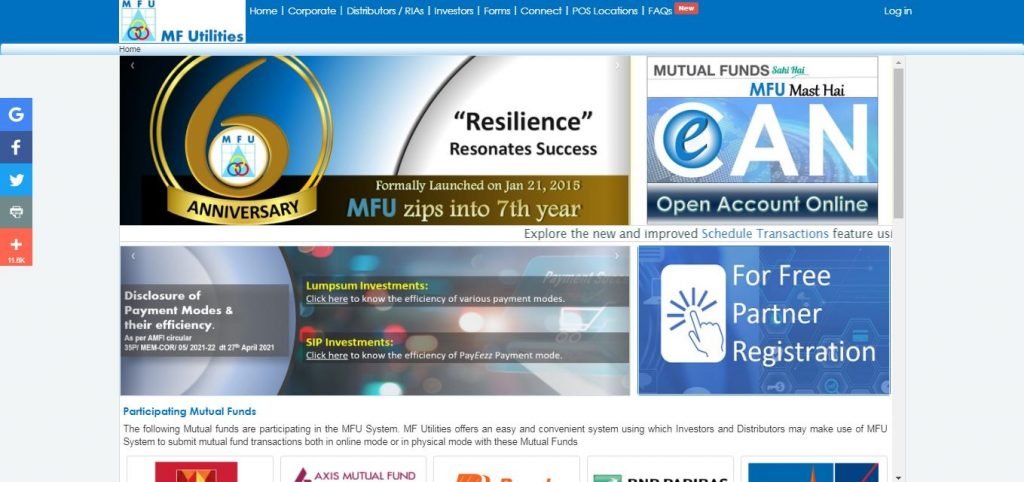Finance Dragon Opinion: Upcoming Common Platform for Mutual Fund Investments
Recently, news reports mentioned that the Securities and Exchange Board of India (Sebi) had asked mutual fund (MF) Registrar and Transfer Agents (RTAs) to form a centralised platform to simplify mutual fund investments and help investors access all trading and non-trading facilities at one place.
The platform once formed will initially help investors perform non-financial transactions such as update their address or contact details, track any queries or complaints and get access to reports of their mutual fund holdings including details such as capital gains and losses, unclaimed dividends and so on. Later on, you will be able to buy and sell mutual funds from this platform without having to go through the mutual fund company’s website or your broker.
The platform will be available as a website and as an app.
The best thing about the platform is perhaps that it minimises the need to provide your paperwork to multiple brokers or mutual fund companies. Doing it once on the platform will be enough.
This centralised solution will likely help all stakeholders such as investment advisors, distributors, Asset Management Companies (AMCs) that create and operate mutual funds, stock exchanges and fintech businesses to transact in mutual funds in a much more streamlined way.
Major stakeholders such as AMCs, RTAs and depositories will have to reconcile their processes to work with each other. SEBI has already asked them to review and agree to harmonize the processes across the industry to provide a single-window, integrated, simplified investment and service experience for investors.
As of now, the launch schedules are:
Phase I: Launch of non-financial transactions on the website by December 31, 2021
Phase II: Launch of the app
Phase III: Launch of financial transactions where you can buy and sell (or redeem, in industry jargon) your mutual funds.
Development of the platform
The platform will be developed by RTAs, which are businesses that track and record all mutual fund transactions for AMCs.
SEBI has asked AMCs to help the RTAs in the development of the platform. The mutual fund companies will provide their data in real-time through Application Programming Interfaces (APIs) and as mentioned collaborate with each other to collate and sort the data so you get a unified report of your investments and holdings.
Let us quickly understand why a unified report of your investments and holdings is important.
A unified report is important as currently, you get different reports from different AMCs when you have invested in their funds.
This means that if you own mutual funds from, say, SBI and Kotak, then SBI AMC may give you one report, Kotak another and so on.
If you use a stockbroker, they may give you a unified report but there is nothing to prevent them from not doing so. They can simply offer you the reports of different AMCs and you will have to track all your investments yourself. Though most large brokers give you unified reports, it is really up to them to do so or not. This problem compounds if you use a small broker who will not have the resources to create a unified report for you.
Analysing and managing all these reports and using them to arrive at your net assets is a hassle at the very least.
Though the AMFI had come up with initiatives such e-CAS that offers a consolidated view of the investor’s MF holdings and MF Utilities, another AMFI-backed venture, helps people get a consolidated view of their portfolio through something called a Common Account Number (CAN). But these initiatives suffer from, we believe, two primary problems:
- First is the difficult user interface that makes it nearly impossible for someone new to understand what’s to be done (have a look at the MF Utilities interface below)
- Second is the complex procedures, especially for the retail investor, to get a report that should be hers by right with just a click of a button

Considering all of this, the SEBI initiative is a welcome move that will provide a single platform for anyone who wants to invest in mutual funds directly.
In addition, thanks to the platform, AMCs, RTAs and depositories will have to streamline their processes to work with each other. This is likely to make the website and app platform a simple investment and service experience, especially for retail investors.
As a result, more people will likely join as investors – something the AMFI has been trying for years to promote through initiatives such as ‘Mutual Funds Sahi Hain’ and so on.
The literal billion-rupee question is whether the platform will be user friendly
If you have checked statutory or quasi-statutory websites, you will notice that nimbler and more tech-aware private players pip them to the finish line when it comes to user-friendliness and ease of use. Even though experts expect this new website to be simpler and better, it is unlikely to be outclassed by what some of the new discount brokers and even traditional brokers already offer.
Something that gives these brokers an added advantage is that they will have access to your other investments also if you have invested through them. Therefore, any report they generate will give you a better picture of all your assets / investments on any given day.
Nonetheless, if you are a smart mutual fund investor and want to stay invested for the long term, then the new platform is likely to offer you better returns (e.g. direct mutual funds and hence no broker fees) than what brokers can offer.
But like all investments, this remains to be seen.
Brokers may come up with features that help you get better returns (e.g. the Smallcase initiative by Zerodha, now available with a lot of brokers such as Upstoxx, 5Paisa, HDFC and so on).
Let us know what you think.
